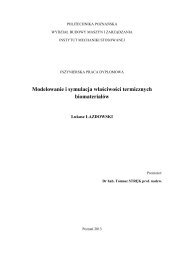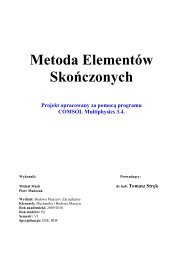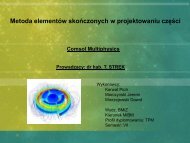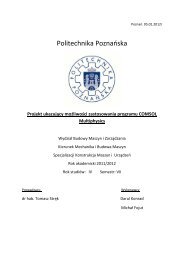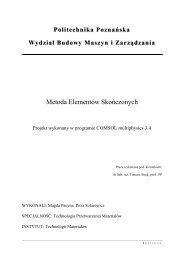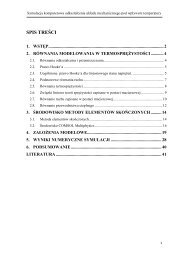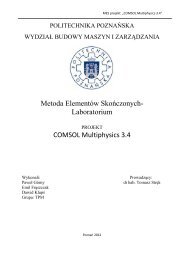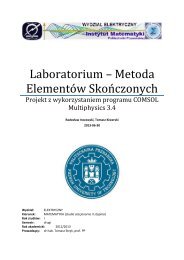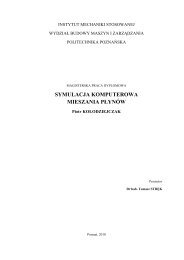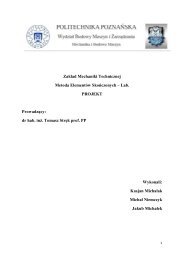COMSOL News
COMSOL News
COMSOL News
Create successful ePaper yourself
Turn your PDF publications into a flip-book with our unique Google optimized e-Paper software.
HEAT TRANSFER<br />
RUUKKI METALS OY, HÄMEENLINNA, FINLAND<br />
Optimized Heating Process with Uniform Coating<br />
Optimizing the Ruukki Metals color coating process increases product throughput and helps achieve<br />
higher and uniform quality.<br />
BY MIKA JUDIN, RUUKKI METALS OY<br />
“ I recently created a model<br />
in <strong>COMSOL</strong> Multiphysics<br />
to assist in the optimal<br />
running of the heating/<br />
paint-drying oven for<br />
surface-coated roofing,<br />
façade, and panel<br />
materials.”<br />
When coating rolled metal with<br />
paint, it’s important that the coating<br />
be applied such that it’s not discolored<br />
or damaged through; for example, overheating<br />
or even boiling, which can cause<br />
pitting. The process must also result in<br />
an end product with good weather resistance<br />
and a long service life. Another goal<br />
is to eliminate waste and increase process<br />
throughput and production rate. With<br />
these aspects in mind, I recently created<br />
a model in <strong>COMSOL</strong> Multiphysics to assist<br />
in the optimal running of the heating/<br />
paint-drying oven for surface-coated roofing,<br />
façade, and panel materials.<br />
Rautaruukki Oyj supplies metal-based<br />
components and systems to the construction<br />
and mechanical engineering industries.<br />
It has operations in approximately 30<br />
countries, and annual sales in 2011 were<br />
almost 3 billion Euros.<br />
At one of the divisions,<br />
Ruukki Metals Oy in Hämeenlinna,<br />
we manufacture<br />
weather-resistant<br />
steel raw material for<br />
roofing and other building<br />
parts as well as for<br />
the domestic appliance<br />
industry. Other Ruukki<br />
Metals products include<br />
wear-resistant steels for<br />
applications such as excavator buckets,<br />
cutting edges for earthmoving machines,<br />
wearing parts for mining machines, concrete<br />
mixers and wood-processing machines.<br />
In addition, our high-strength<br />
steels are used in various vehicles, transportation<br />
equipment, tipper bodies, lifting<br />
equipment booms and containers.<br />
Coating Roofing<br />
Sheet Metal<br />
One application for our products is the<br />
manufacture of sheet metal for roofing,<br />
and here building contractors and owners<br />
are particularly concerned about having<br />
the proper color (shade, gloss, reproducibility)<br />
as well as a long-lasting product.<br />
Our color-coating process for roofing sheet<br />
metal takes place on a system that is<br />
equipped with two ovens with several oven<br />
zones (Figure 1). Currently, steel sheets<br />
move through this at a rate of 45 to 90<br />
meters/minute. The metal strip entering<br />
the process already has a coating of a zinc<br />
alloy on top of which the paint is applied.<br />
The settings for the oven — temperature<br />
at various stages and the speed of the<br />
material through the oven — vary considerably<br />
depending on the base material, its<br />
composition and thickness, and the paint<br />
(Figure 2). We had been searching for a<br />
tool to help us quickly determine and enter<br />
the proper settings. Earlier, I created<br />
a theoretical model based on a differential<br />
equation to calculate the thermal curves<br />
Figure 1. Outline depiction of the color coating process. The coating is applied where<br />
the strip is a yellow color, while the oven zones are where the strip is a red color.<br />
Figure 2. The layers in a typical roofing sheet: 1.<br />
Zinc layer 2. Passivation layer 3. Primer 4. Coating<br />
5. Steel sheet 6. Zinc layer 7. Passivation layer 8.<br />
Primer 9. Protective paint coat.<br />
during the drying process. However, it<br />
could not properly estimate internal heat<br />
transfer, and only through separate calculations<br />
could I estimate the time it takes<br />
to achieve a steady temperature difference<br />
in the oven.<br />
I first used <strong>COMSOL</strong> Multiphysics to<br />
determine the heat conductivity of the<br />
paint during the drying process in a 3D<br />
model. I then used it to model the whole<br />
oven drying process. From a geometry<br />
standpoint it’s a simple model, but even so,<br />
the physics in the multiple layers we are<br />
investigating can become quite complex<br />
because we are modeling heat transfer, a<br />
liquid-to-vapor phase change (moisture being<br />
driven out) and a liquid-to-solid phase<br />
change (paint pigments<br />
turning to a solid, and this<br />
without any change in color<br />
or other properties). To find<br />
the process settings, the<br />
model calculates the heat<br />
distribution on both sides<br />
of the zinc-coated steel as a<br />
function of time; we want to<br />
know the temperature distribution<br />
of the metal strip<br />
that is coated with several<br />
4 2 // <strong>COMSOL</strong> NEWS 2 0 1 2<br />
<strong>COMSOL</strong> <strong>News</strong> 2012-17.indd 42<br />
➮<br />
Cov ToC + – A<br />
➭<br />
5/15/12 3:00 PM



